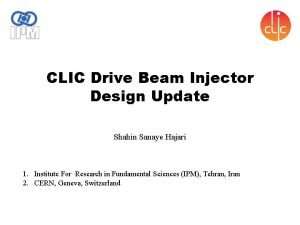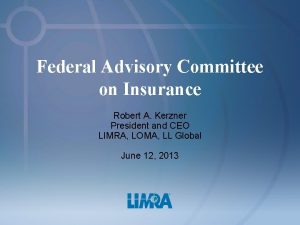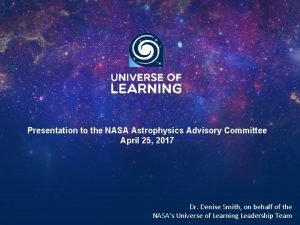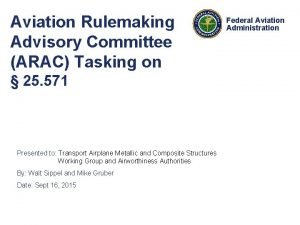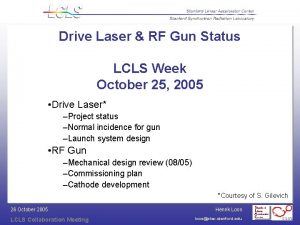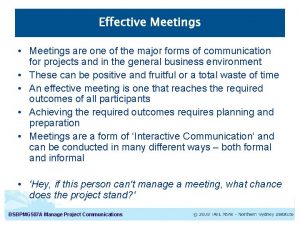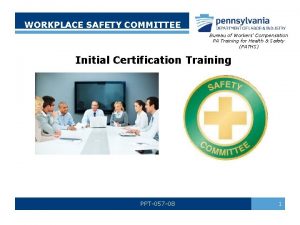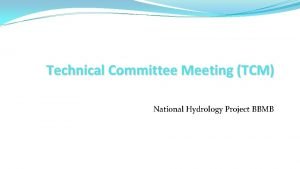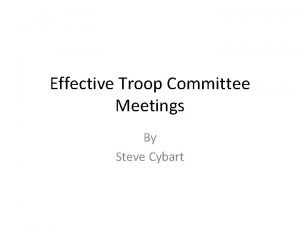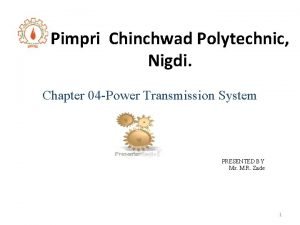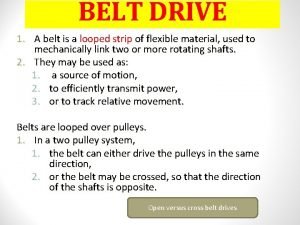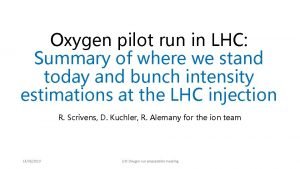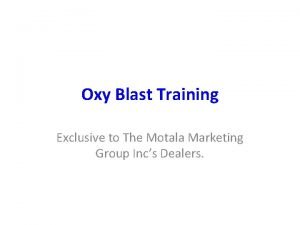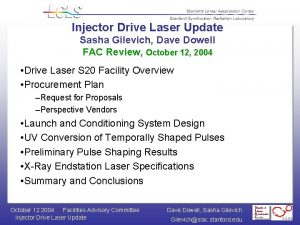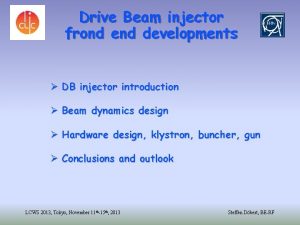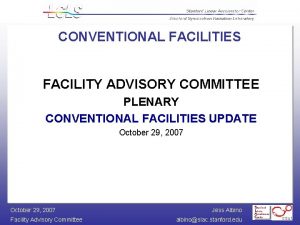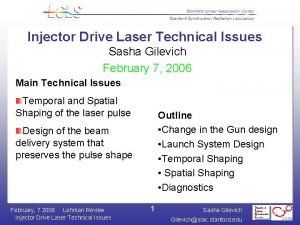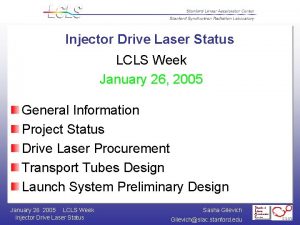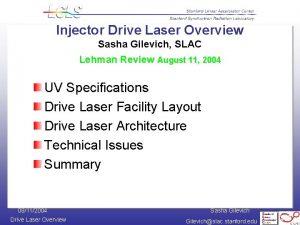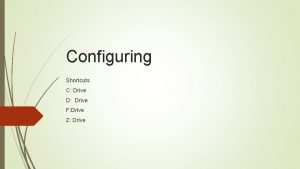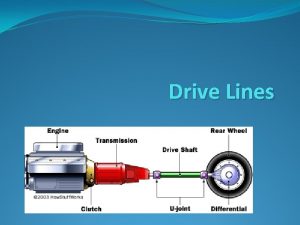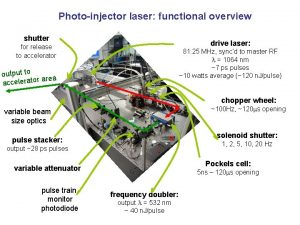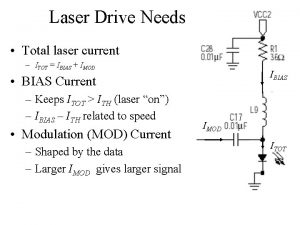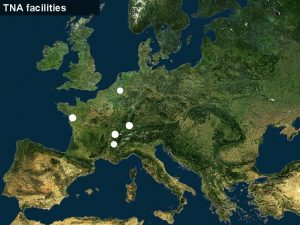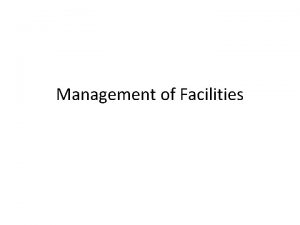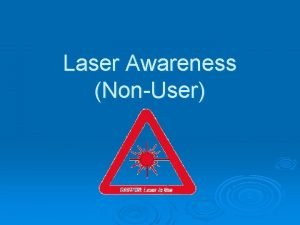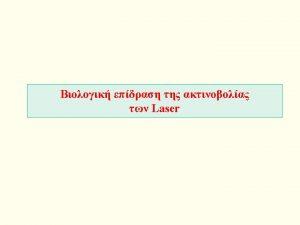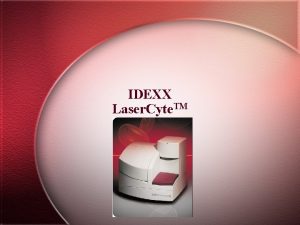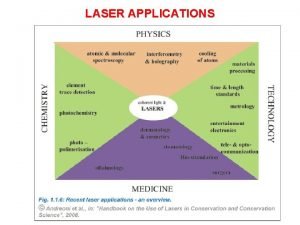Injector Drive Laser Update Facilities Advisory Committee Meeting























- Slides: 23

Injector Drive Laser Update Facilities Advisory Committee Meeting October 27, 2005 • Project Status • Drive Laser • Change in the Gun design • Launch System Design • Transport tubes Installation • Response to the April FAC recommendations • Summary October 27 2005 Facilities Advisory Committee Injector Drive Laser Update 1 Sasha Gilevich@slac. stanford. edu

Project Status The contract for the Drive Laser was awarded to Thales Lasers. Design review was held October 18 - 20 Construction of the S 20 drive laser facility is underway. Old building has been demolished Requirements to the electrical and water systems were defined based on the Thales laser system requirements Design of the electrical system is near completion. Beneficial occupancy is planned for February 2006 The Laser safety system design is underway. The laser safety review planned at the end of November October 27 2005 Facilities Advisory Committee Injector Drive Laser Update 2 Sasha Gilevich@slac. stanford. edu

Project Status The laser beam transport tubes were installed. Tubes passed the leak check Design of the optical tables completed. Procurement process started Design of the active beam steering stabilization system started. The system will be tested in Build. 407 Parts for the test were defined and ordered Optical Design of the Launch System for normal incidence completed The draft of the Drive laser Commissioning schedule is put together Schedule is being synchronized with the commissioning schedule for the gun October 27 2005 Facilities Advisory Committee Injector Drive Laser Update 3 Sasha Gilevich@slac. stanford. edu

Project Status R&D effort is underway. LLNL completed modeling of the UV temporal pulse shaping. The UV conversion modeling code was completed and run on a number of cases. It was shown that to obtain efficient, temporally uniform UV pulses that we need to convert the IR beam to a spatial flat-top before frequency conversion. The temporal diagnostics designs were finished. For UV and blue measurements TG FROG was proposed. Orders were placed. ANL performed spatial shaping of broadband IR pulses using the Newport aspheric beam shaper. Optimum shaping conditions were defined. It was shown that extent of the bandwidth significantly affects the quality of shaping Work to arrange the collaboration with INFN and Elettra started October 27 2005 Facilities Advisory Committee Injector Drive Laser Update 4 Sasha Gilevich@slac. stanford. edu

Thales Drive Laser System 150 ps 80 m. W 119 MHz 400 m. W Femtolasers Oscillator Femtosource Scientific 20 s (chirped mirrors) Stretcher 1. 5 mx 3. 75 m footprint (~4. 5’x 11. 5’) DAZZLER RGA Regen Amp 5 W, 119 MHZ Spectra Physics MILLENIA Vs JEDI #1 100 m. J, 120 Hz 1 m. J, 120 Hz Pre-Amp 4 -pass Bowtie Amplifiers are not cryo-cooled IR stability <1%rms (short term) 20 m. J, 120 Hz 80 m. J, 120 Hz >20 m. J, 120 Hz To cathode >2. 5 m. J, 120 Hz THG Amplifier 2 -pass Bowtie Compressor >25 m. J, 120 Hz October 27 2005 Facilities Advisory Committee Injector Drive Laser Update >40 m. J, 120 Hz 5 JEDI #2 100 m. J, 120 Hz Sasha Gilevich@slac. stanford. edu

Thales Drive Laser System General Set-up October 27 2005 Facilities Advisory Committee Injector Drive Laser Update 6 Sasha Gilevich@slac. stanford. edu

Cathode Launch System Design Grazing incidence vs. normal incidence Grazing incidence Advantages No in-vacuum mirror=> no wake Requires no space in gun-to-linac region Increased QE for P-polarization Disadvantages Requires grating to tilt the beam without introducing temporal slew and to produce round beam. Grating has less than 50% efficiency Large bandwidth with grating causes chromatic aberration Dispersed beam requires large optics (expensive!) Limited/complicated adjustment of beam size on cathode Low damage threshold of grating in UV October 27 2005 Facilities Advisory Committee Injector Drive Laser Update 7 Sasha Gilevich@slac. stanford. edu

Cathode Launch System Design Grazing incidence vs. normal incidence Normal incidence Advantages Simple launch optics Launch optics allow continuous variation the beam size on the cathode Easy to preserve required temporal shape Disadvantages In-vacuum mirror causes transverse wake Lower QE Requires space in the gun-to-linac region In-vacuum mirror requires careful design October 27 2005 Facilities Advisory Committee Injector Drive Laser Update 8 Sasha Gilevich@slac. stanford. edu

Normal vs Grazing Incidence Grazing incidence optics add risk to laser shaping Wakes from dual in-vacuum mirrors tolerable We have changed the design to normal incidence October 27 2005 Facilities Advisory Committee Injector Drive Laser Update 9 Sasha Gilevich@slac. stanford. edu

Preliminary Gun Design for Normal Incidence Layout of Laser from Injection Mirror to Cathode gun solenoid cathode laser injection cross vacuum valve drawing compliments of R. F. Boyce & T. Osier October 27 2005 Facilities Advisory Committee Injector Drive Laser Update 10 Sasha Gilevich@slac. stanford. edu

Optical Design of the Transport and Launch System uses the aspheric beam shaper which transforms Gaussian beam into flat-top System allows continuous adjustment of the beam size on the photocathode Spatial Shaper and Zoom system for beam diameter adjustment are located in the laser bay upstairs Shaper output is imaged with adjustable magnification to the input of the relay system that images it to the photocathode through the transport tube October 27 2005 Facilities Advisory Committee Injector Drive Laser Update 11 Sasha Gilevich@slac. stanford. edu

Vacuum cell Layout Zoom Beam shaper UV converter Table in the tunnel Virtual Cathode Steering system Transport tube Photocathode Active Steering Stabilization October 27 2005 Facilities Advisory Committee Injector Drive Laser Update 12 Sasha Gilevich@slac. stanford. edu

Beam Profile on the Cathode ZEMAX Modeling October 27 2005 Facilities Advisory Committee Injector Drive Laser Update 13 Sasha Gilevich@slac. stanford. edu

Beam Profile on the Cathode ZEMAX Modeling October 27 2005 Facilities Advisory Committee Injector Drive Laser Update 14 Sasha Gilevich@slac. stanford. edu

Adjustment of the Beam Diameter October 27 2005 Facilities Advisory Committee Injector Drive Laser Update 15 Sasha Gilevich@slac. stanford. edu

10 mm Beam Size on the vacuum mirror Radius on the cathode = 1. 5 mm Radius on the cathode = 0. 6 mm Size of the vacuum mirror – 14 mm October 27 2005 Facilities Advisory Committee Injector Drive Laser Update 16 Sasha Gilevich@slac. stanford. edu

Photocathode Launch System Optical system provides flat-top beam on the cathode System allows continuous adjustment of the beam radius on the photocathode from 0. 6 to 1. 5 mm. Smaller (than 0. 6 mm) beam size can be achieved by using smaller aperture after the beam shaper Design avoids small beam size on optics, which could cause damage October 27 2005 Facilities Advisory Committee Injector Drive Laser Update 17 Sasha Gilevich@slac. stanford. edu

Transport Tubes Installation October 27 2005 Facilities Advisory Committee Injector Drive Laser Update 18 Sasha Gilevich@slac. stanford. edu

Transport Tubes Installation October 27 2005 Facilities Advisory Committee Injector Drive Laser Update 19 Sasha Gilevich@slac. stanford. edu

Transport Tubes in the Vault October 27 2005 Facilities Advisory Committee Injector Drive Laser Update 20 Sasha Gilevich@slac. stanford. edu

Response to the April FAC Recommendations Strengthening of the laser team The LCLS Laser Group leader– Bill White – started in May Long term staffing plan for the group has been developed One engineer was hired October 27 2005 Facilities Advisory Committee Injector Drive Laser Update 21 Sasha Gilevich@slac. stanford. edu

Response to the April FAC Recommendations Coordination of the laser R&D activities Coordination of the efforts of LLNL and ANL is centralized in the LCLS Laser Group. As design elements are completed at LLNL and ANL, they are incorporated into the final design which is then reviewed by all interested parties. Purchase of the second laser The purchase of a second laser is not in the current baseline, but we hope to get it in the future Laser Bay has space and power for two lasers October 27 2005 Facilities Advisory Committee Injector Drive Laser Update 22 Sasha Gilevich@slac. stanford. edu

Summary First LCLS injector item – Laser transport tubes were installed Design of the gun has been changed to normal incidence. It significantly simplifies the optical set-up and the makes beam shaping less problematic Manufacturing of the Drive Laser and R&D work according to the schedule October 27 2005 Facilities Advisory Committee Injector Drive Laser Update 23 Sasha Gilevich@slac. stanford. edu
 Injector update
Injector update Googlehttps://drive.google.com/drive/my-drive
Googlehttps://drive.google.com/drive/my-drive Slide todoc.com
Slide todoc.com Google drive rit
Google drive rit Is an alternative of log based recovery
Is an alternative of log based recovery Federal advisory committee on insurance
Federal advisory committee on insurance Nasa astrophysics advisory committee
Nasa astrophysics advisory committee Aviation rulemaking advisory committee
Aviation rulemaking advisory committee Yashpal committee report pdf
Yashpal committee report pdf Trade union advisory committee
Trade union advisory committee Rf drive laser
Rf drive laser Steering committee meeting agenda sample
Steering committee meeting agenda sample Safety committee meeting ppt
Safety committee meeting ppt Tcm technical committee meeting
Tcm technical committee meeting Boy scout troop committee organization chart
Boy scout troop committee organization chart Https drive google com drive u 0 recent
Https drive google com drive u 0 recent Difference between open belt drive and cross belt drive
Difference between open belt drive and cross belt drive Cross belt drive
Cross belt drive Mpgu
Mpgu 1https://drive.google.com/drive/u/1
1https://drive.google.com/drive/u/1 Biolab oxygen injector
Biolab oxygen injector Oxy blast
Oxy blast Chapter 42 gasoline injection diagnosis and repair
Chapter 42 gasoline injection diagnosis and repair Mazzei injector selector
Mazzei injector selector
